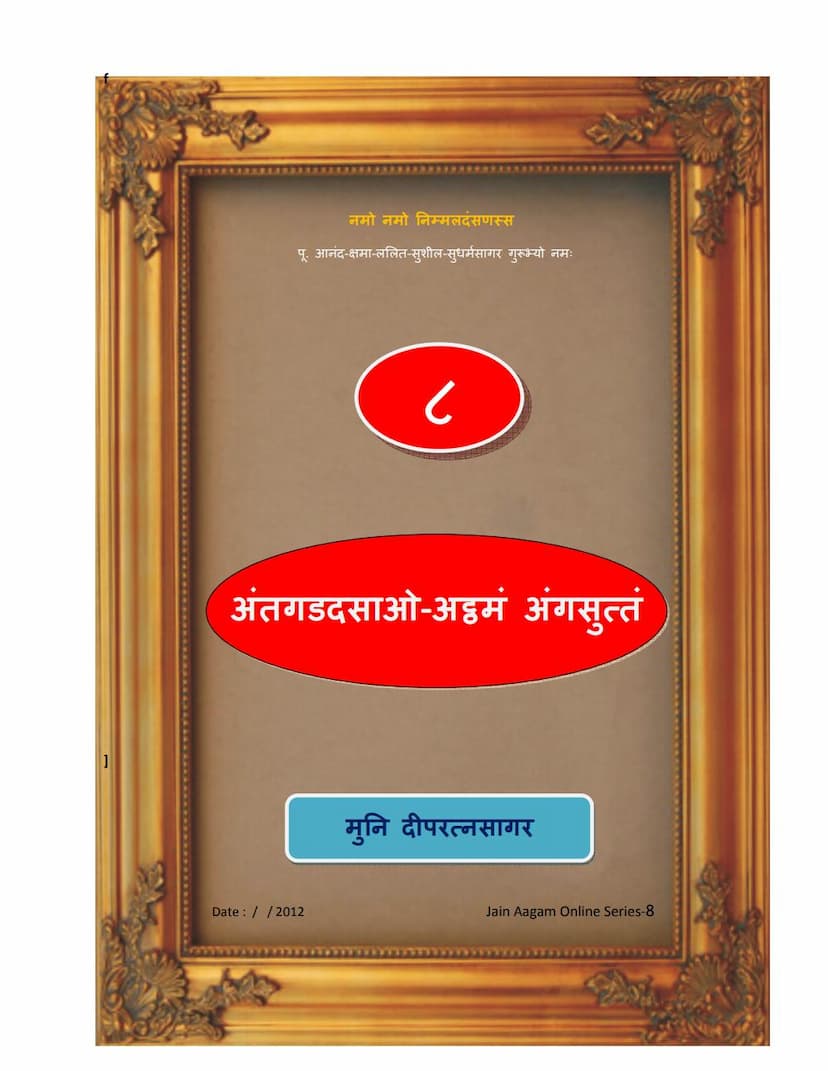Agam 08 Antgaddasao Attham Angsuttam Mulam PDF File
Added to library: September 1, 2025

Summary
This document is a Jain Agam text, specifically Antagadadasao (The Endless Ones), which is the eighth Anga (limb) of the Jain canon. It is part of the Jain Agam Online Series.
Here's a breakdown of its content based on the provided text:
I. Structure and Content:
- Book Title: Agam 08 Antgaddasao Attham Angsuttam Mulam PDF File
- Author/Editor: Munishri Deepratnasagar (or Dipratnasagar)
- Publisher: Deepratnasagar
- Purpose: For private and personal use only (Jain Education International).
The text is presented in a structured manner, detailing the "Ganthānukkamo" (Table of Contents) by chapter (Adhyayana) and section (Vagga).
- Eight Vaggas (Sections): The text is divided into eight main sections.
- Chapters within Vaggas: Each Vagga contains a specific number of chapters (Adhyayanas), ranging from 10 to 16 chapters depending on the Vagga.
- Content Focus: The Antagadadasao primarily describes the lives and attainments of those who achieve nirvana (liberation) from the cycle of birth and death. The summaries of individual chapters highlight various individuals, their families, their kingdoms, their spiritual journeys, and their eventual liberation.
II. Key Individuals and Narratives:
The text recounts the stories of numerous individuals, often kings, princes, princesses, and their families, who renounced worldly life to embrace asceticism and ultimately achieve liberation. Some prominent figures and events mentioned include:
- Kṛṣṇa (Kanh): A significant figure, often depicted in relation to King Vasudeva and Devaki. His life events, including family life, encounters with ascetics, and eventual renunciation, are detailed.
- Arishtanemi (Arittanemi): A Tirthankara (spiritual teacher) who plays a role in guiding many characters towards liberation.
- Goyama: A disciple who renounces his royal life.
- Khandaka: Mentioned in relation to renunciation and the practice of penance.
- Anihasaka, Anantseṇa, Vitraseṇa, etc.: Various princes and individuals from different cities and backgrounds who undertake rigorous spiritual practices.
- Sulaṣā and Nāga Gāhapatī: Parents of Anihasaka.
- Devakī and Vasudeva: Parents of Kṛṣṇa and Balarama.
- Somila Brāhmaṇa and Somiśrī: Parents of Soma.
- Arjunamālākara: A florist who faces significant trials and ultimately achieves liberation.
- Sudarśana Seth: A merchant who witnesses Arjunamālākara's suffering and renounces his worldly life.
- Numerous Queens and Princesses: Including Padmavatī, Goryā, Gandhari, Lakṣaṇā, Susīmā, Jambuvatī, Satyabhāmā, Rupinī, Mulśirī, and Mūldattā, who also embark on spiritual paths.
- The "Six Brothers" (Chha Anagārā): Ascetics who undertake severe penances.
III. Themes and Practices:
The core themes and practices described in the text revolve around:
- Renunciation (Nikkhamana/Pravrajyā): The act of leaving behind worldly possessions, family, and status to become an ascetic.
- Penance and Austerity (Tapa/Tavokamma): The rigorous practice of self-discipline, fasting, and other austerities for spiritual purification. Various specific forms of penance are mentioned, such as Chatthachhatta (fasting for six days) and the "Jewel Garland" (Ratnavali) penance.
- Right Faith, Right Knowledge, Right Conduct (Samyak Darshan, Samyak Gyan, Samyak Charitra): The foundational principles of Jainism guiding the spiritual path.
- Karma Theory: The actions of individuals and their consequences are central to the narratives.
- Liberation (Siddhi/Moksha): The ultimate goal of overcoming the cycle of birth and death and achieving a state of eternal bliss.
- The importance of the teachings of Tirthankaras: Particularly Lord Mahavir and Arishtanemi, in guiding individuals towards liberation.
- The influence of divine beings (Yakshas): Some narratives involve Yakshas who either hinder or assist individuals in their spiritual journey.
IV. Narrative Style:
The text follows a typical style of Jain Agam literature, often beginning with phrases like "Teṇam kāleṇaṁ teṇaṁ samayeṇaṁ" (At that time, in that era) and using extensive descriptions of cities, kings, and their lives. The stories often serve as examples of the consequences of karma and the path to spiritual attainment.
In essence, Antagadadasao is a collection of exemplary lives of individuals, primarily from royal and affluent backgrounds, who, after experiencing various life events, choose the path of asceticism and intense spiritual discipline to ultimately achieve liberation from the cycle of rebirth. It serves as a guide and inspiration for followers of Jainism, illustrating the principles and practices that lead to spiritual perfection.